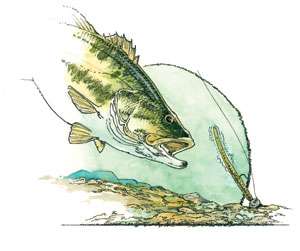
When some anglers think of finesse worms they think sissy baits, something suitable only for a rank amateur who can't catch a bass any other way. Those who hold that opinion might want to take note, however. No less an angler than Kevin VanDam regularly fishes with them. In fact, they're his go-to bait when the bite gets tough and he needs fish in his livewell.
We asked for his six best techniques for these plastics. Here's what he had to say:
1 THE SHAKY HEAD
A shaky head jig, rigged with a straight-tail finesse worm, is the No. 1 co-angler bait in the nation. I guarantee you there's nothing better you can throw when you're in the back of the boat, and a lot of times when you're in the front. This setup will catch bass when nothing else works.
Rig it straight so that your worm tends to drift upward, away from the weight of the shaky head. Shake it around a little bit and occasionally lift it off the bottom. This rig is good anywhere there's a relatively clean, hard bottom — shallow or deep, clear or muddy water. Keep it away from brush and heavy grass— it'll hang.
Your tackle choice is optional. You can fish a shaky head on baitcasting or open-faced spinning tackle. I always use a Strike King Tour Grade Shaky Head. It's the best. Adjust the weight of the head according to conditions.
By midsummer, my new Strike King KVD Finesse Worms should be on the market. They're part of our Perfect Plastics line and will be offered in 5-inch and 6 1/2-inch versions. The 5-inch model will give you a more subtle presentation. The 6 1/2-inch model has more action. There'll be a color choice that's suitable for any venue.
2 DROP SHOT
This is an excellent rig if you're fishing around docks or heavy brush. My standard presentation is to rig Texas style with a No. 2 Mustad Drop Shot Light Wire Hook and a 5-inch worm. That's a good compromise between making a weedless bait and getting the action you need.
For smallmouth, especially in the Great Lakes, a wacky rig seems to do a little better. I hook the worm through the egg sack.
I adjust my tackle and weight to match conditions. The tougher the bite, the more I downsize. The hotter the bite or the bigger the fish, the more I upsize my tackle. It's a decision you'll have to make based on experience and the water you're fishing.
3 CAROLINA RIG
Rig it Texas style through the head of the worm with a Mustad Ultra Lock Offset Wire Worm Hook. Use a short leader if you want a soft and subtle presentation. Lengthen your leader for more action.
This rig is especially useful during post-frontal conditions when the sky is high and clear. I typically fish this rig over flats when I'm looking for scattered bass that are off their bite.
Adjust your weight — I prefer a Mojo-style sinker — according to the conditions. In 5-feet-deep water I'll typically use a 1/2-ounce sinker and 14-pound-test Bass Pro Shops XPS Fluorocarbon line. Deep water and wind call for more weight. Shallow water and calm conditions, or an especially tough bite, call for a lighter presentation.
4 UNWEIGHTED TEXAS RIG
In the spring I frequently toss a Texas rigged straight-tail worm up in the shallows. Hook it through the head. Twitch it along much like a soft plastic jerkbait. Allow it to sink from time to time if the bite's especially tough.
At one time my best colors were bright — yellow, white or bubblegum. Recently, however, I've had better success with natural colors — watermelon and green pumpkin. I'm not really sure why. Go with a 6 1/2-inch worm. You want all the action you can get.
I always use open-faced spinning tackle with this rig and presentation. Eight to 10-pound-test Bass Pro Shops XPS line is about right. My new worms are heavily salted. That makes them heavy enough to cast effectively.
5 FINESSE PITCHING AND FLIPPING
For this spring and fall technique, I Texas rig my worms with light weights. That means a 1/8-ounce sinker most of the time. I have, however, gone as heavy as 3/16 ounce and as light as 1/32 ounce. (This is finesse fishing. You're not trying to break through heavy cover, just through open holes in it.)
I never peg my weight. I want the worm and the weight to separate. That gives the plastic better action. Better action means more bites with this presentation.
Use the heaviest baitcasting tackle you can handle. My line is usually 17-pound-test Bass Pro Shops XPS Fluorocarbon line. It takes a little practice to learn to pitch and flip with a light weight and heavy tackle. It's well worth the effort, though. This presentation will often fill your livewell when nothing else can.
6 A WACKY RIG
This one's as old as dirt, and about that simple. Nevertheless, it catches fish today just like it did in the past.
I like to hook my worm just a little bit up from the center so that the head end is shorter than the tail end. That seems to generate the best action, for me anyway. I use a weighted hook — Mustad makes a really nice one — or I'll insert a small lead nail in the head for better movement.
This is a target rig that's at its best during, or immediately after, the spawn when the water's clear and the bass are oriented toward specific pieces of cover or structure. Get it as close to bushes or clumps of grass as you possibly can. Then twitch it along for a foot or so before you let it die.




